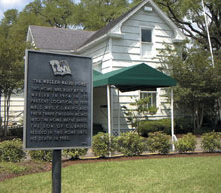 MKT Depot and Caboose MKT Depot and Caboose
5615 First Street in Railroad Park. Restored Katy Depot with MKT Museum, Visitors Center and caboose. Open from 9:00 a.m. to 3:00 p.m. Monday through Friday and from 10:00 a.m. to 2:00 p.m. on Saturday. The Katy Heritage Society was established in 1979 by a group formed to save the old MKT Railroad Depot. With the help of the City, the Depot was acquired and restored by the Heritage Society. Other historical structures have been acquired and restored by the Society. All of their structures are now located at Katy Heritage Park, 5990 George Bush Drive. The group continues itís work to protect and preserve the historic resources of Katy. Please contact the Katy Heritage Society at 281-391-2550 for the History of Katy. Katy Heritage Society |

